Visiting the City of London: our favorite attractions and photo spots
The Tower of London at dusk with the Shard rising high into the sky across the river.
At the historic core of modern London is the district known as “the City of London”. This oldest area of London is both a thriving, modern financial district and a place packed with history.
As a visitor to London, I found this area full of interesting details and juxtapositions. It is a mix of old and new, characterized by modern skyscrapers like the Shard and the Gherkin, alongside ancient landmarks like the Tower of London and St. Paul’s Cathedral. This also makes the City of London very photogenic!
Nicknamed the Square Mile, or simply “the City”, the City of London dates back to Roman times when it was established as a center of commerce. Today, it is still home to key financial institutions like the Bank of England and the London Stock Exchange.
Flowers in the late afternoon sunshine outside Saint Paul’s Cathedral. This is a moment where the flip-out screen on my Canon R5 camera came in very handy to get this low angle.
It is interesting to note that “the City of London” refers to a specific area, and not the entire Greater London - which is actually a metropolis of an astounding 32 boroughs, plus the City of London, its original center.
To explore this intriguing district, I've put together a personal walking tour of the City of London that lists our favorite points of interest and photo spots.
This walk is in a specific order that makes sense to me, but of course you might need to mix this up to accommodate your own itinerary and interests. It starts with the very old and ends with - well, a little less old but still pretty old, from the Tower of London to St. Paul’s Cathedral.
And, if you are still feeling game after this walk, cross the river via the Millennium Bridge and try adding on John’s walk along the Thames, detailed in his richly illustrated post, A photo walk along the River Thames in London.
The sun on St. Paul’s is gorgeous in the afternoon.
Our City of London Walk
Beginning at the Tower of London and ending at St. Paul’s Cathedral, this walk includes historic sites, noted landmarks, and stops that we enjoyed. If not making stops, you could do this in an hour to an hour and a half. Or it could take the whole day if you stop for lunch or to take photos or interior tours. Whatever suits your fancy!!
Fun fact - Throughout the City of London, look for names of streets that harken back to the earliest days of trade in the area. Wood Street, Milk Street, Bread Street and Trump Street (relating to the sale of trumpets, not any current political figures!) all are named for the industries that once operated there.
Tower of London
An exhibit of red ceramic poppies commemorating the 80th anniversary of the end of World War 2.
With its warm tones of Kentish ragstone and its iconic castle shape, the medieval fortress known as the Tower of London has been standing near the banks of the River Thames for centuries. Let’s start our walk here.
You can get to the Tower of London by Underground, via the District or Circle lines to Tower Hill Tube station.
If the Tower is on your agenda to actually visit, book your tickets for an early tour so there is plenty of time to explore the rest of the area afterward.
If you’ve never been before, I recommend you visit the Tower of London at least once. The ticket is a little bit expensive, but this landmark is packed with British history (not all of it pretty!!).
Most visitors know that the Tower is where the famous Crown Jewels of England are kept, and this is a very popular attraction. I do think the Jewels are worth seeing (though you aren’t allowed to take photos in that chamber.) Prepare to be dazzled!
Besides housing the Crown Jewels, the Tower of London has played numerous important roles in English history. It was attacked several times throughout its long existence, and controlling the Tower has historically been key to controlling the country.
A member of the Household Guard outside the Crown Jewels inside the Tower of London.
The Tower of London has served at different times as an armory, a treasury, a menagerie, the home of the Royal Mint, and a public records office. As recently as the First and Second World Wars, it was actually still used as a prison! Which is sort of mind-blowing to me. It was bombed heavily during the Blitz but later restored, and is today one of the most popular tourist attractions in London.
And, just a side note, you can get quite close for a mini Changing of the Guard ceremony without too much fuss. The Guards walked right past us and through the crowd to perform this duty. Nice photo op! 😉
But if a visit inside isn’t on your list today, that’s quite ok! It’s still very impressive to look at from the outside, and very photogenic. Look to frame it up with the iconic Tower Bridge nearby, or the juxtaposition of modern London skyscrapers like the Shard behind the Tower.
Late afternoon sunlight on the outside wall of the Tower of London.
Looking for more info on the Tower of London? We have a full blog post here: Complete guide to visiting the Tower of London
London’s Roman Wall
A statue of Roman Emperor Trajan in front of the Roman wall outside the Tower Hill Tube station.
When you are done at the Tower of London, walk towards the Tower Hill Tube station for an interesting glimpse of ancient history. Around the corner, past the station, you'll see a section of the London Roman Wall.
Established by the Romans around the year 47 BC, the City of London was then known as Londinium. (Catchy, right?) The boundaries of this prosperous ancient settlement, believed to be approximately the same as those of the City of London today, were fortified by a protective wall. This surviving piece of the London Wall is said to have been built sometime between 190 and 225 AD.
It’s not that much to look at, really, but it is worth a quick stop just to appreciate something so old, still standing strong in this very modern city.
Today’s London actually has many things in common with dear old Londinium. In its heyday, Londinium was a busy, populous, ethnically diverse city with inhabitants from across the Roman Empire, including natives of Britannia, continental Europe, the Middle East, and North Africa.
It is so interesting to me that anywhere I’ve gone in Europe, there has been a Roman ruin or two. Or three or four. One really begins to tacitly understand the reach of the Roman Empire.
Moving on, you can get a look at another much larger and well-preserved section of the London Wall in the courtyard just behind the CitizenM Tower of London hotel, on Cooper's Row.
St Dunstan-in-the-East Church Garden
The inside courtyard of St Dunstan-in-the-East.
Continue west to St Dunstan's Hill to find the ruins of St Dunstan-in-the-East.
This magical little garden spot is one of the most photogenic spaces we’ve come across in London. A peaceful garden, surrounded by the ruined walls of what once was a very, very old, historic church.
After surviving multiple restorations and being rebuilt by Sir Christopher Wren after the Great Fire of 1697, St Dunstan’s was severely damaged during the London Blitz of WW2. But there was an effort to try and save what was left, for there had always been a church on this site since Saxon times.
What remains today is a stony framework of picturesque, ivy-draped exterior walls open to the air and Wren’s tower, all carefully preserved as a public garden. Benches are arranged around an interior fountain, providing a gentle, serene atmosphere.
A peaceful place to take a break and contemplate life!
You can read more about Saint Dunstan’s in our post: Visiting picturesque St Dunstan-in-the-East Church Garden in London
Feeling peckish? - If you started your day with a full-blown tour of the Tower of London that took a couple hours, you may be getting hungry by now. This is a great area to try a classic London pub for lunch.
There are plenty of nice pubs to choose from in the Tower Hill area. We tried Hung, Drawn & Quartered, which is close to St. Dunstan’s. They served up fresh, good pub fare and offered the kind of atmosphere we were looking for.
We went for the Sunday Roast, which was fun and traditional with all the savory roasted veggies on the plate you’d expect to get, along with our protein of choice. I had the sirloin and John opted for the roast chicken. And what would Sunday Roast be without Yorkshire pudding & gravy? Yum!
Other dishes being served around us looked tasty too. A good, solid, and very enjoyable “pub experience”.
If you only walked by the Tower of London and didn’t spend much time there, it might be a bit early for lunch at this point, so we would suggest grabbing lunch at Leadenhall Market a little later down the road.
The Garden at 120
A view of the “Wallkie-Talkie” building from the Garden at 120.
Walk north from St. Dunstan’s to 120 Fenchurch Street, where you can get a great, free rooftop view of the City of London at the Garden at 120.
The Garden is located on the 15th floor of 120 Fenchurch, and while it's not as high a vantage point as the excellent Sky Garden (which is right down the street atop the wacky, wobbly, wonderful, Walkie-Talkie building), Garden at 120 is London’s largest public rooftop space. And it’s free!
It really is a lovely, open-air space, with an interesting, 200-foot-long moving water feature, 85 Italian wisteria trees, 30 fruit trees, and close almost “touchable” views of some of London’s most iconic buildings, new and old: the Gherkin, the Shard, the Walkie-Talkie, Tower of London, Tower Bridge - the gang’s all here for you to peep at.
We found the Garden at 120 easy to visit. There was virtually no line at all when we got there around 10am, and an elevator takes you right up to the 15th floor. It was not crowded and, unlike visiting the Sky Garden, we didn’t need advance tickets.
For more free views, see our blog post about the Best Free Views of the London Skyline.
Interesting note - While up at the Garden at 120, we looked down at an interesting construction site below at 50 Fenchurch. I was taken in by the site of an old-looking church tower suspended on stilts in the middle of the excavation site!
What I learned later after some snooping was that a 35-story skyscraper is being built on the site. But the 700-year-old Tower of All Hallows Staining is being preserved and will be integrated into the design of the new building. Publicly accessible gardens at ground level and the 10th floor will feature the historic church tower as a design element.
Interesting! Completion is targeted for 2028, so will this become part of our walking tour? Time will tell! In the meantime, it is just interesting to see the engineering feat of that suspended old tower!
Leadenhall Market
Heading north from The Garden at 120, turn onto Leadenhall Street to find Leadenhall Market, a covered Victorian market with eateries, boutiques, and pubs.
While not exactly a “hidden gem”, (it’s been used as a location for several popular films), this market is definitely less talked about than Borough Market or Covent Gardens. But it goes way back - there has been a market on this site since the 14th century.
The wonderfully detailed arcade we see today hearkens back to the 19th century Victorian era and was designed by Sir Horace Jones, who also designed Smithfield Market, Billingsgate Market and Tower Bridge.
This well-preserved piece of history is both covered and outside - the best of both worlds in London - so it's a great place to stop for lunch if you haven’t done that already. Or perhaps just to grab a coffee, tea, snack, or a pint and take in the scenery.
Details to look for: Above the many entrances to Leadenhall Market are elaborate stone pediments carved with dragons, swags, shields and other designs that are symbols of City heraldry. The differences in the size of these emblems reflect the hierarchy of the entrances, with the larger ones having the market’s name and date inscribed on them.
Note - This blog post contains affiliate links. If we recommend a product, activity, or hotel, we might receive a small commission if you buy or book from these links. This is done at no additional cost to you. We only recommend products we have personally used or have thoroughly researched.
Royal Exchange
After exploring Leadenhall Market, walk west towards Bank Junction to see the Royal Exchange. Admittedly, it isn’t on everyone’s list of things to see in the City, but I rather like it.
The Royal Exchange is a bit of a curiosity to me. Though today it’s pretty much a high-end shopping mall, housing luxury shops, swanky restaurants, and a few financial offices, this historic building dates back to the 16th century and has several interesting features that caught my imagination.
Diners at Fortnum & Mason inside the Royal Exchange.
Though it looks rather “bank-like” on the outside, the inside has a magnificent glass-covered atrium supported by stunning architecture of arches and columns. It’s all rather grand and palace-like, meant to evoke prosperity.
Shops line the perimeter under the arches, and several fancy restaurants are located on the “mezzanine” level. There is even a luxury restaurant in the “vaults” beneath the main level.
Like many historic buildings in London, the Royal Exchange has seen many changes through its long life, burning down in the Great Fire, surviving the bombs of two World Wars, and weathering changing fortunes and attitudes.
Though today it is mostly retail space, the Exchange has actually served many purposes in its history, from being an original trading floor and financial base, to early versions of shopping centers, to housing the Mermaid Theater. (!!) It strikes me as a place of “great importance” that was always trying to figure out what to do with itself. (But aren’t we all guilty of that?)
But it is significant to note that the Royal Exchange continually played a role as a sort of rallying point for the Empire, when town criers would take to the steps of the Exchange for important declarations.
Even today, it still serves a unique role as the place where the City Proclamation is made for a new sovereign, one of only four such sites throughout London where the proclamation is read. So even as recently as 2022, with the ascension of King Charles III, the Royal Exchange played its part as the proclamation was read from these steps with pomp and splendor, following a long tradition that has been taking place for centuries.
The luxury department store Fortnum & Mason has a satellite location here that occupies a good deal of the space on the main floor. While the F&M main location on Piccadilly is frequently cited as one of the “best places to have tea in London”, I think this lesser-known location offers its own unique charm. F&M’s restaurant and bar is located under the airy atrium, and I really would have fancied having tea there! But alas, it was not to be! Here’s my advice on that - make a reservation.
And here’s one of the most quirky bits about the Royal Exchange - Did you know there are historic murals hidden behind shops on the lower level? These are a series of highly stylized panels under the arches that depict British history. The first of these paintings were placed around 1892, and the last just after World War One, so they are all more than 100 years old and museum quality. But today they are hidden by the shops built in front of them!
But you can still see them (for free) from mezzanine level by visiting the Engel bar or Jang restaurant. All you have to do is ask.
Another interesting feature is the Troops Memorial for the fallen of WWI out front of the building. It is just rather curiously standing amongst outdoor seating tables for one of the restaurants - but obviously, those tables weren’t always there. It does make the memorial feel a bit modest, though.
Lastly, there is the weathervane atop the Exchange in the form of a gilded grasshopper, which was the family crest of Sir Thomas Gresham, who was responsible for building the first Royal Exchange. Supposedly it can be seen from the surrounding streets, but I couldn’t find it. Hope you have better luck!
So the story goes that Gresham’s golden grasshopper became recognized around the world as a symbol of commerce. So when Fanueil Hall was built in Boston by Peter Fanueil, a golden grasshopper weather vane was placed on top of the hall as a symbol of commerce, and a beacon to ships that came into Boston Harbor. Of course, Faneuil Hall became much more than that - playing an important part in the American Revolution.
But that’s another story for another day!
Just like at the Royal Exchange, the gilded grasshopper is still atop Faneuil Hall today (and I’ve read that it has a time capsule inside).
The Walkie Talkie building seen between older buildings.
Our Favorite Travel Resources
Hotels - Booking.com. Lots of search options and information. Link
Activities - Get Your Guide. We love food tours and historical guides from Get Your Guide. Link
Airfare - FareDrop. Custom notifications of airfare sales. Link
Phone connection - Airalo. E-Sim for your phone, it’s easy and available for every country. Link
Note - This blog post contains affiliate links. If we recommend a product, activity, or hotel, we might receive a small commission if you buy or book from these links. This is done at no additional cost to you. We only recommend products we have personally used or have thoroughly researched.
London Mithraeum
Just a short walk from the Royal Exchange, you can step back into Londinium and see an ancient temple that belonged to the Roman cult of Mithras, who used to meet on the site around 240 AD.
Walk south on Walbrook to the Bloomberg building (12 Walbrook), and descend into the London Mithraeum Bloomberg SPACE to see the reconstructed Roman Temple of Mithras, which was discovered during excavations in 1954.
Originally, the Temple was relocated after it had been discovered during excavations for an office building development. The ruin was dismantled and moved to Temple Court, Queen Victoria Street, where in 1962 the foundations were reassembled at street level for an open-air public display. But the reconstruction was not accurate and drew a lot of criticism.
Eventually, what became known as “the Walbrook Square project” was purchased by the Bloomberg company, which decided to restore the Mithraeum to its original site when erecting its new building.
An exhibition space beneath the recently built Bloomberg London headquarters now displays the temple ruins and artifacts where they were found. Special effects of haze, light, the sound of footsteps, chanting and secret whispers add to the mysterious experience.
I think this ancient exhibit being beneath a very modern office building is characteristic of the City of London.
The London Mithraeum is free to enter. You can book a ticket ahead of time, but it’s not absolutely necessary.
One New Change
Saint Paul’s reflected in the windows of One New Change.
Continue west, crossing Queen Victoria Street, to reach One New Change. This is yet another modern shopping and dining complex, but what makes it a worthy stop on our walking tour is the free public rooftop terrace on the sixth floor. Because of its close proximity to St. Paul's Cathedral, the views of the cathedral are unique and stunning from this terrace. It’s like being eye-to-eye to the famous dome.
And, getting to the rooftop in the glass-enclosed elevator is fun too! For photography enthusiasts, taking photos of St. Paul’s from the elevator with all the reflective surfaces makes for great images.
St. Paul's Reflection Garden
The tranquil Reflection Garden.
When you’re done checking out One New Change, walk across the street towards the cathedral to Cannon Street for another great photo op of St. Paul’s.
Here you will find the Reflection Garden, a newly created public garden space with a water feature that creates a mirrored view of St. Paul's dome.
If you are into photography, you will love getting that sweet shot of St. Paul’s reflected in the pool. Though it wasn’t crowded when we stopped by, there were a few other “photo people” there and we enjoyed a little “shop talk” with others in the craft.
But even if you are not into the photo aspect, this is a very quiet, enjoyable spot. It is partially hidden by bushes and somewhat secluded, a “hidden in plain sight” little gem.
St. Paul’s Cathedral
Late afternoon sunshine on the dome of Saint Paul’s.
Finally, we get to our last stop, St. Paul’s Cathedral itself. This iconic Anglican cathedral is located on Ludgate Hill, the highest point of the City of London. It is considered to be Sir Christopher Wren’s architectural masterpiece.
I love St Paul’s Cathedral. We’ve done the inside visitor tour in the past, and while it is really impressive, (that sweeping, painted ceiling!), the funny thing is I get just as much out of just being outside and around it than I did from the tour. I’m not sure why.
Visitors are welcome “to worship, to sightsee and to attend a dynamic programme of events” (from their website); daily services are free to attend, and if you want the full sightseeing experience, you have to purchase a ticket.
Along with multiple galleries and spaces, the ticket includes access to the legendary dome, via a challenging 528-step climb to three different galleries with iconic views of both the cathedral's interior and the London skyline outside. The ticket also includes entrance to the massive crypt, a monumental space that is a historic burial ground for many British national heroes. Notable is the tomb of Lord Nelson, in a striking black marble sarcophagus.
But I really think the outside of St. Paul's symbolizes something special to me. During the Second World War, St. Paul’s became an icon of resilience and resistance, remaining standing as bombs dropped all around London. Just hanging around the Churchyard Gardens thinking about that is a moving experience.


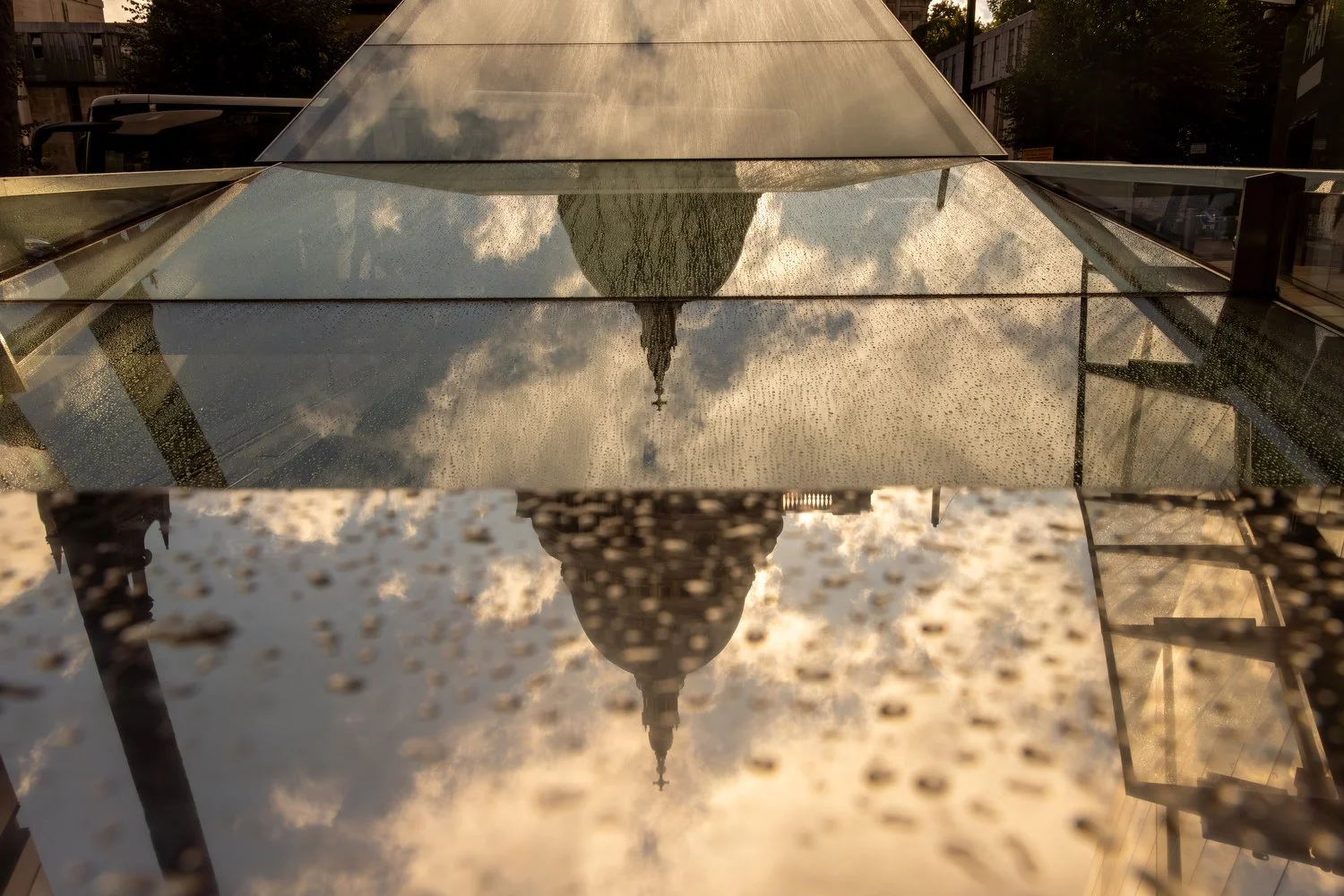

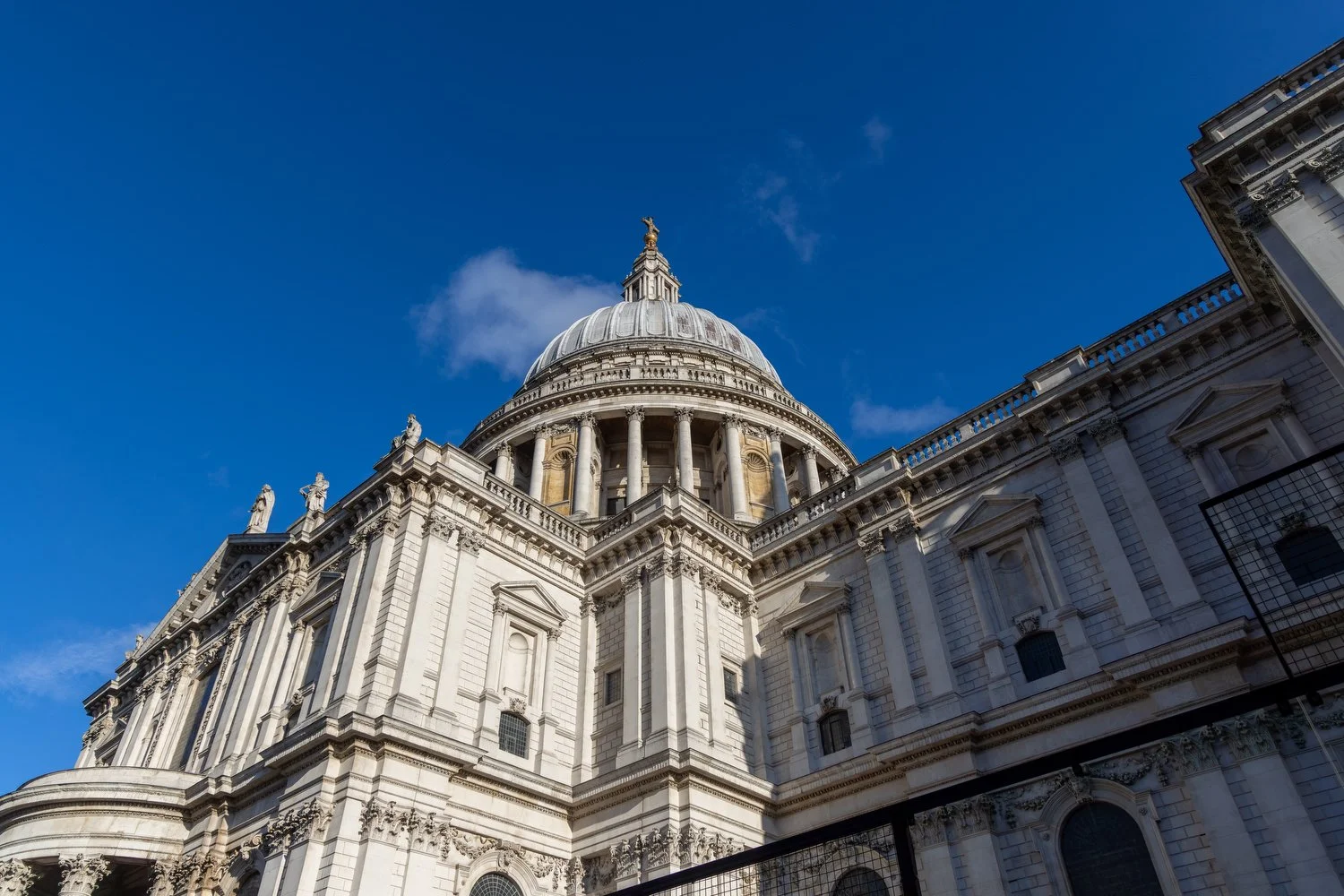
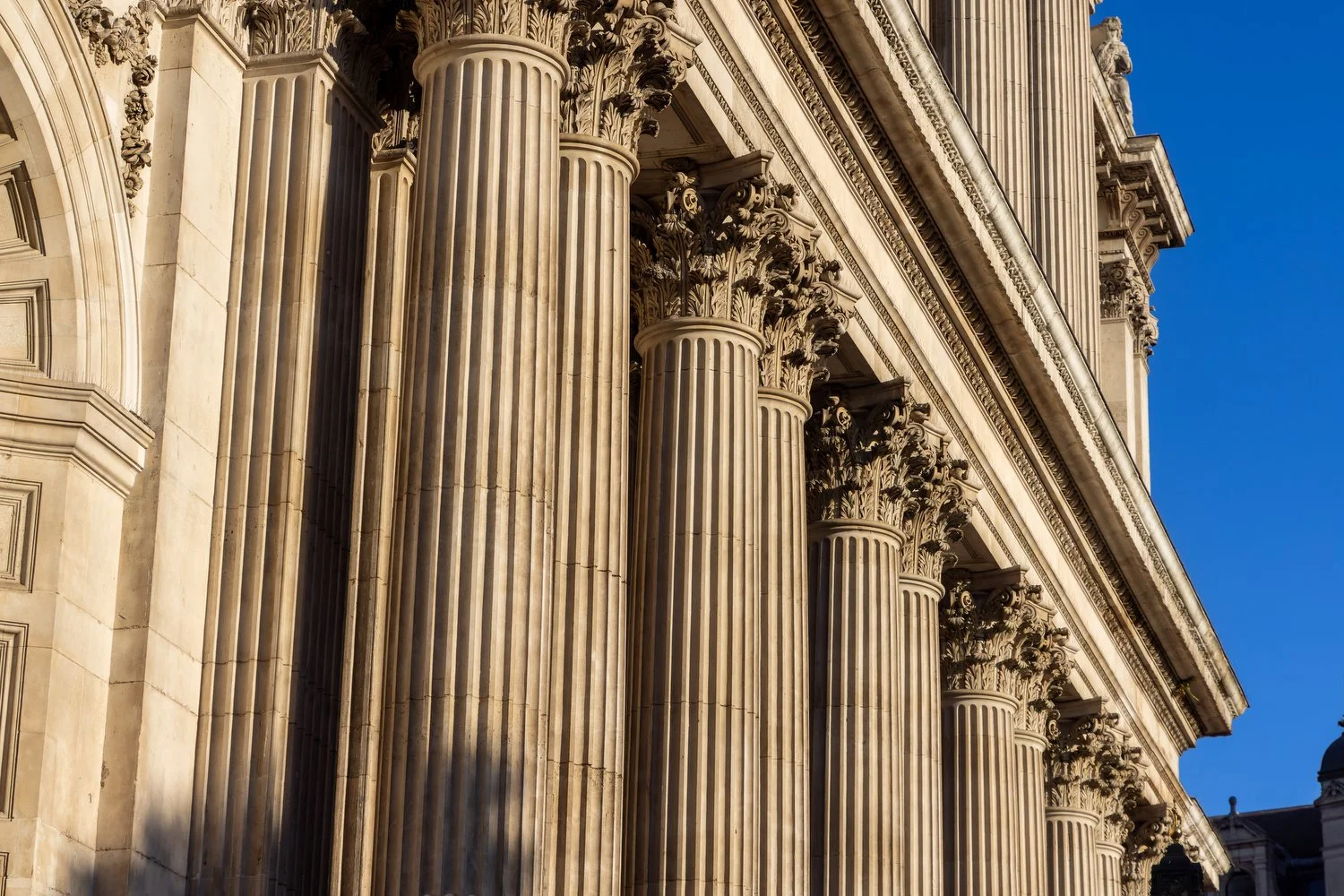


The impact of St. Paul’s on the London Skyline:
Have you ever wondered why the modern buildings that populate London’s financial districts have such odd shapes that provoke clever, descriptive nicknames? The Shard, The Cheesegrater, the Walkie-Talkie, the Gherkin, the Scalpel, etc?
Well, it's all due to regulations that protect views of St. Paul’s Cathedral! That’s how important a national symbol it is.
Along with that, is the fact that the city is not laid out in a uniform grid pattern, so property plots are often irregularly shaped.
Architects have to be creative to work within all these constraints. Plus, let’s face it, they want to make their mark and showcase London as a dazzlingly modern financial hub, and not just a place that still has a king living in a palace.
As you wander through the City of London, look around for random views of these signature buildings peeking through the cityscape along the way.
So that’s it for my City of London walking tour. Remember, if you want to keep going, cross the river via the Millennium Bridge and follow John’s walk along the Thames, detailed in his post, A photo walk along the River Thames in London.
Or, for something completely different, check out funky Shoreditch, one of London’s many distinct boroughs, as laid out in our post Top Shoreditch Attractions for London visitors.
Happy exploring!
This post was researched and written by Debbie of the Empty Nest Explorers. You can learn more about the Empty Nest Explorers here
The sun sets on the City of London. At left is the Walkie Talkie building and at right is the Tower of London.

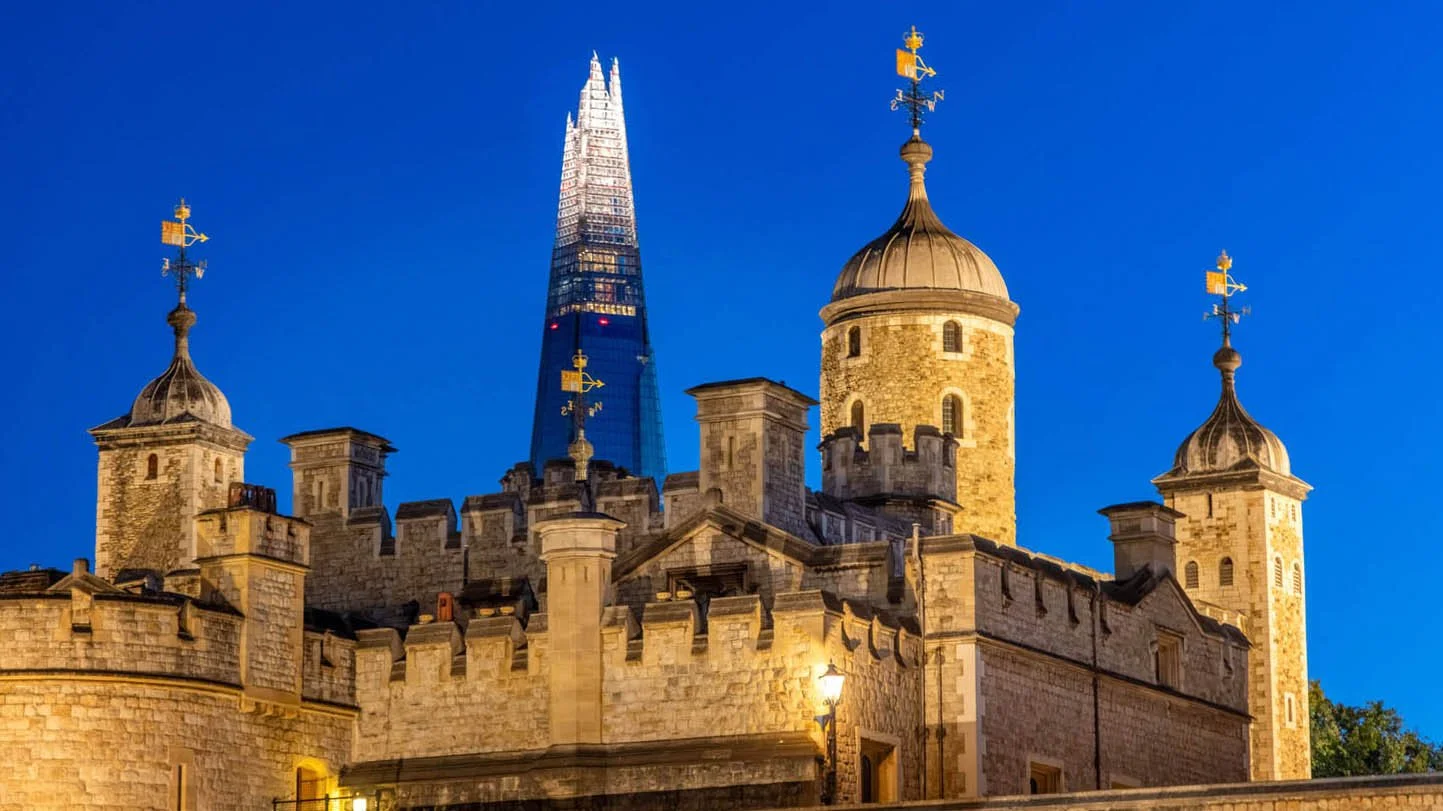
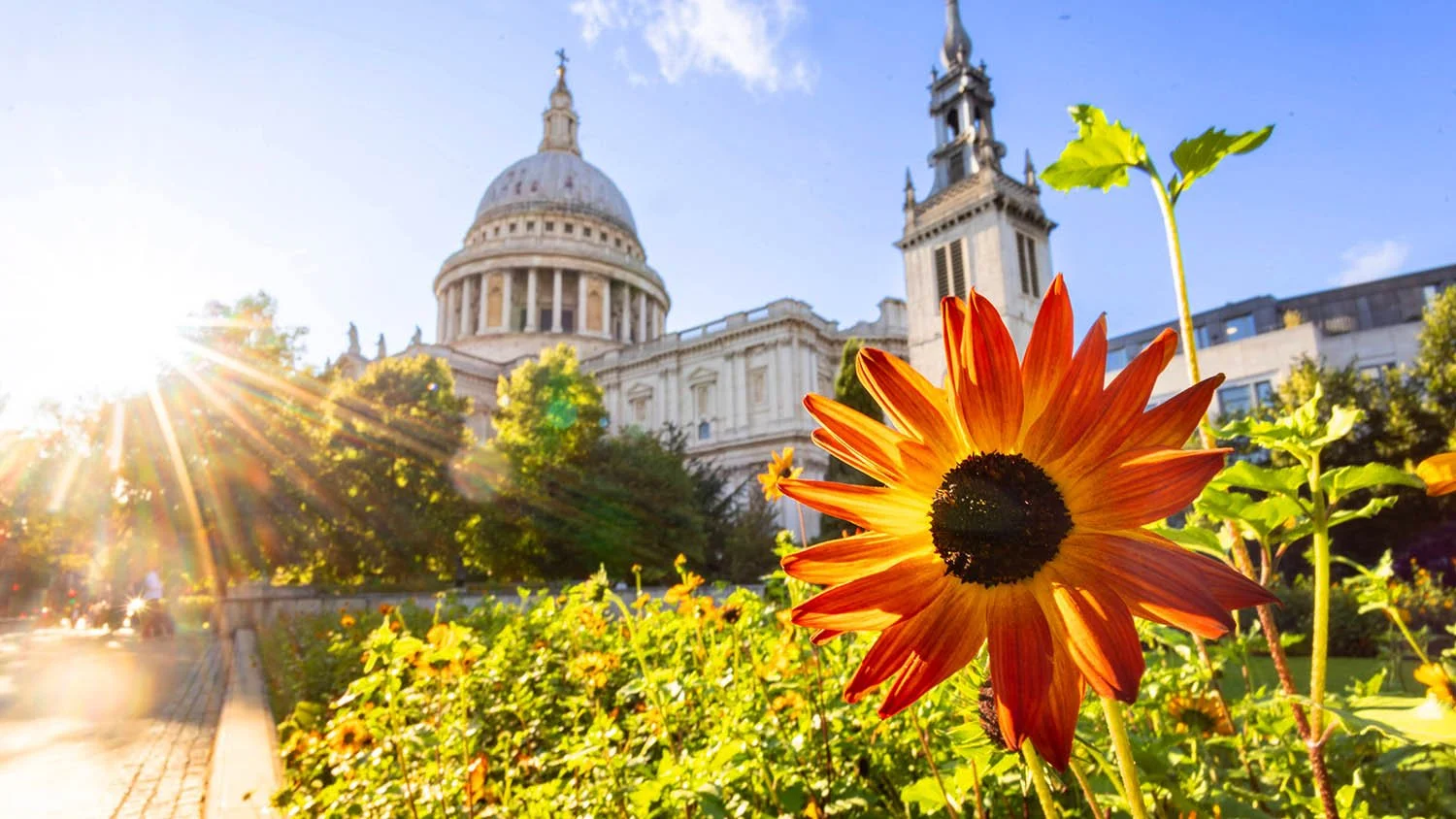
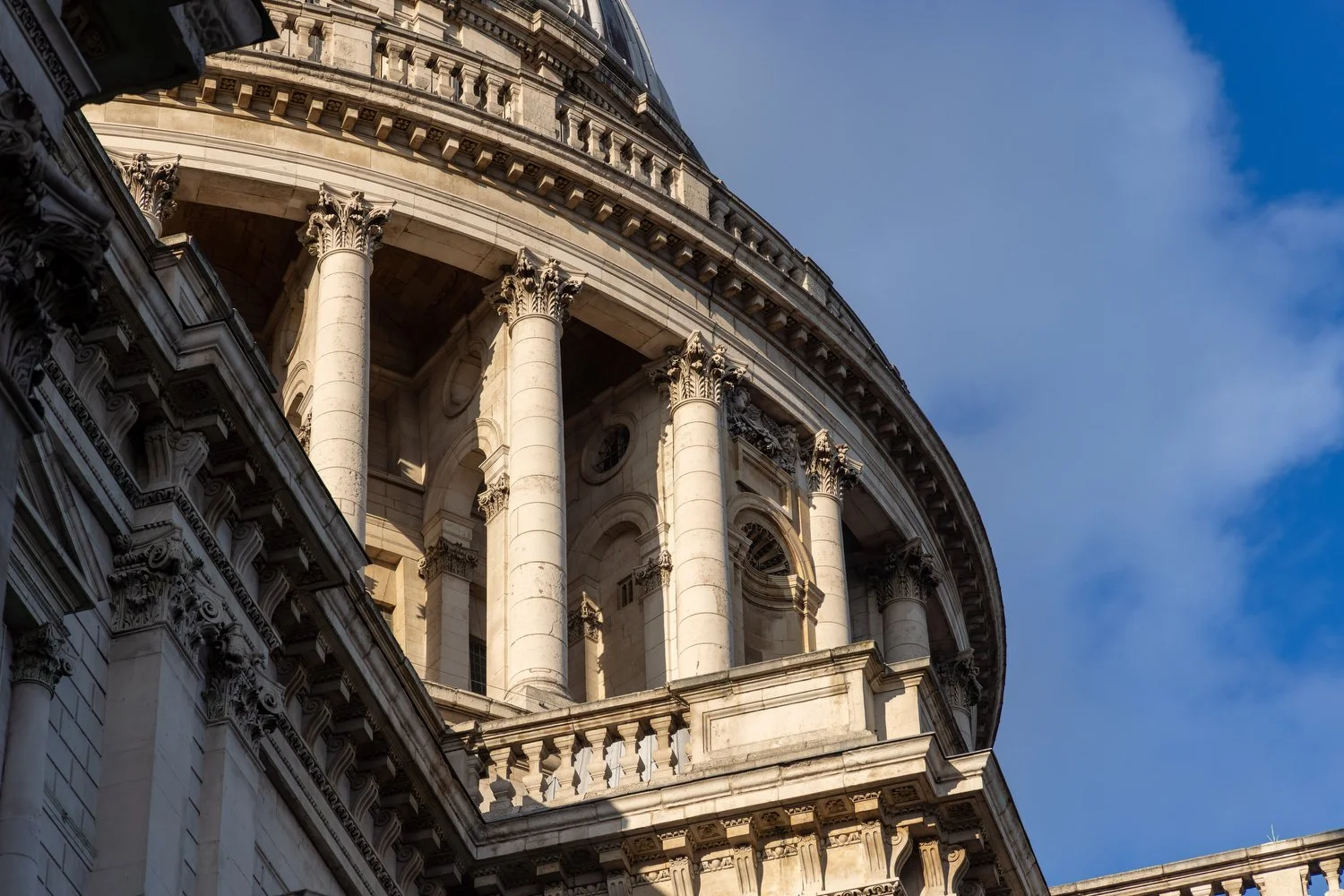
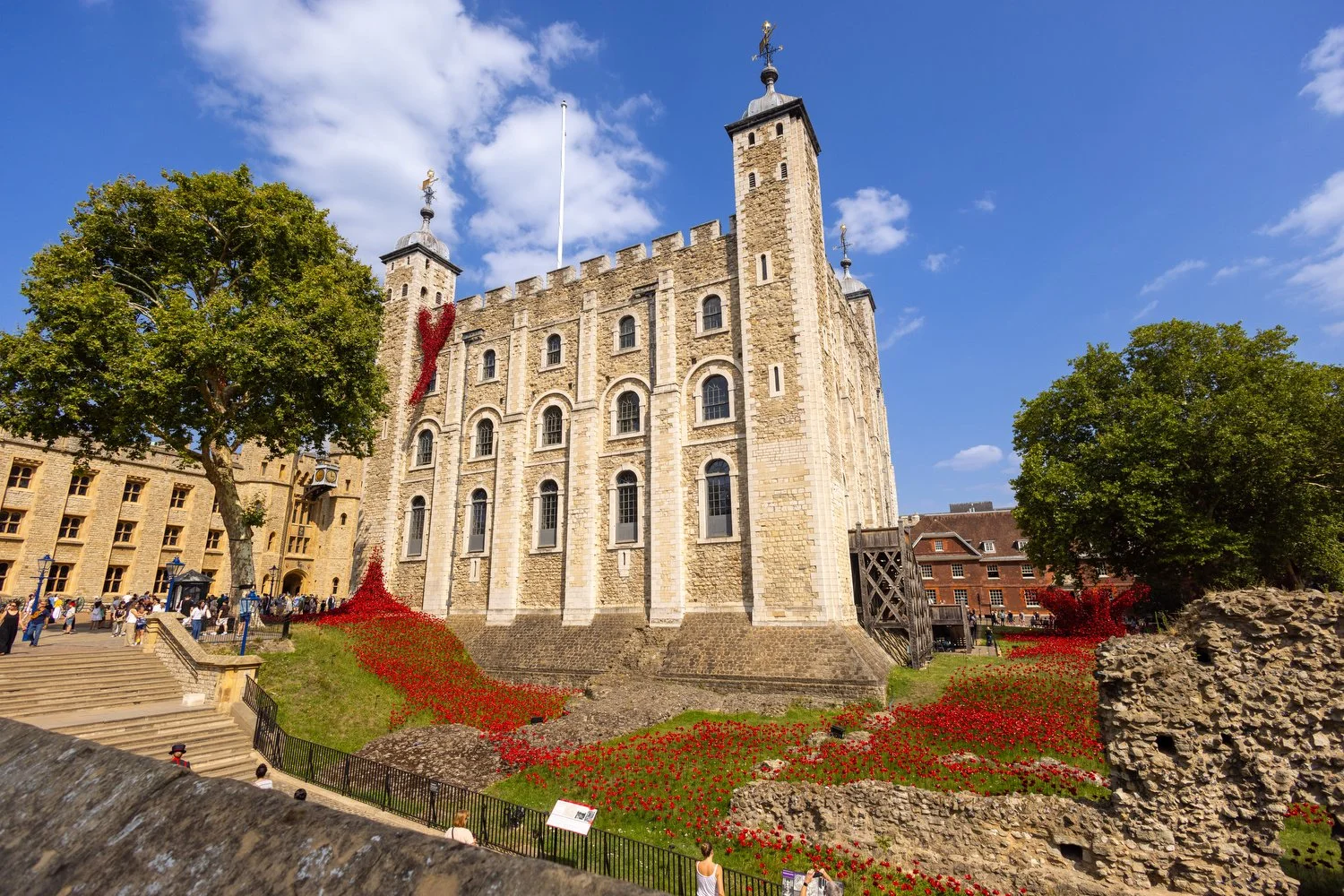
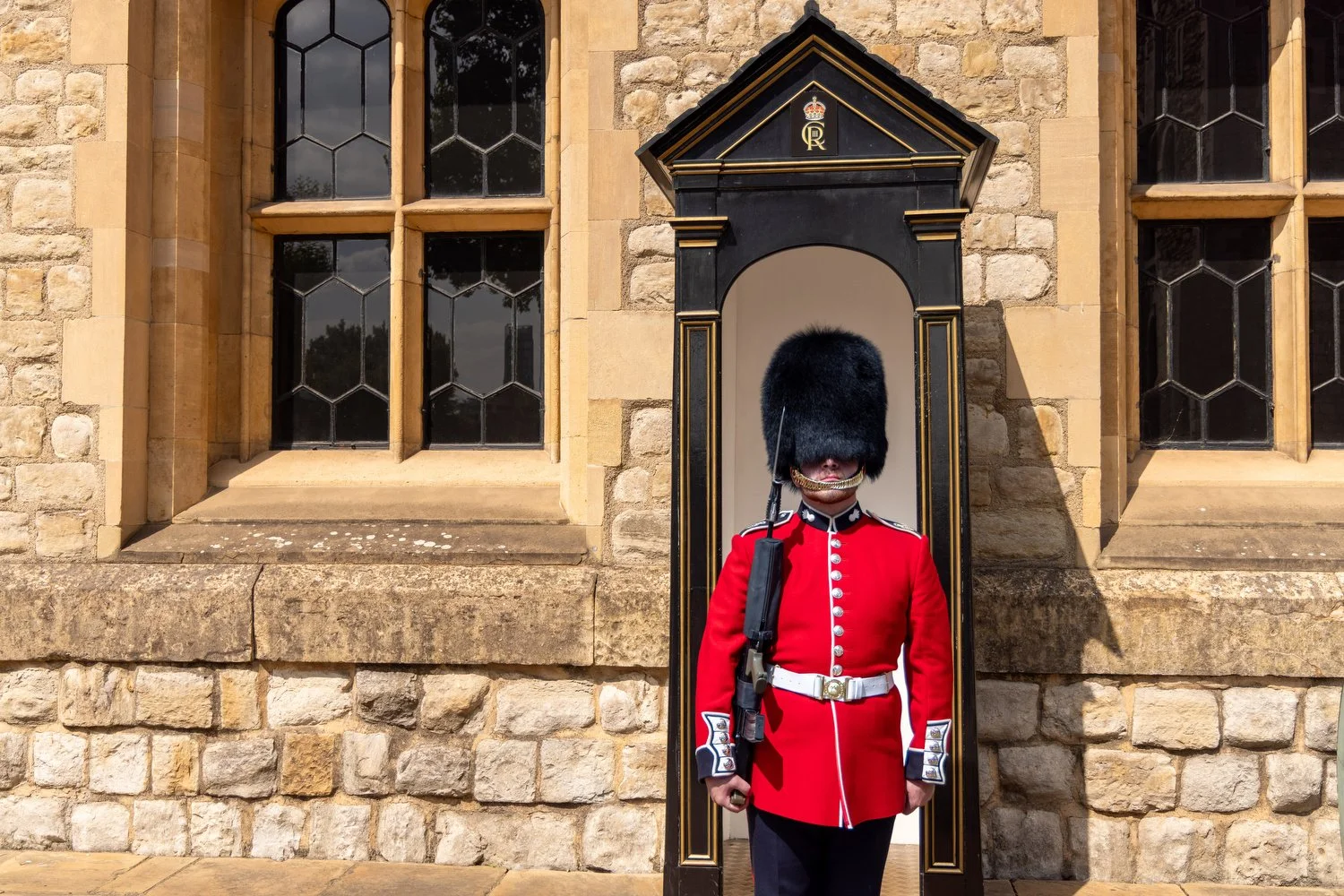
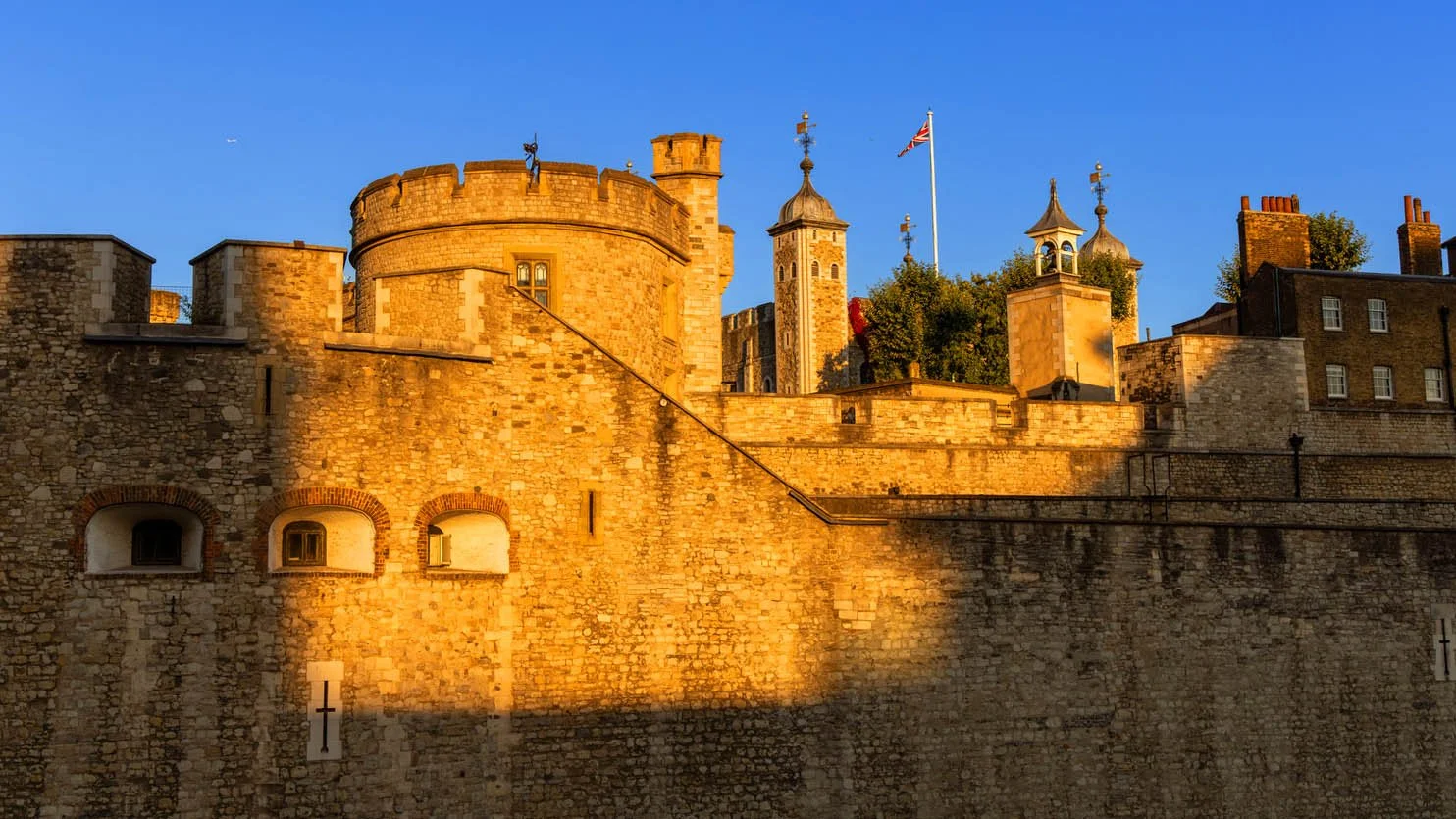
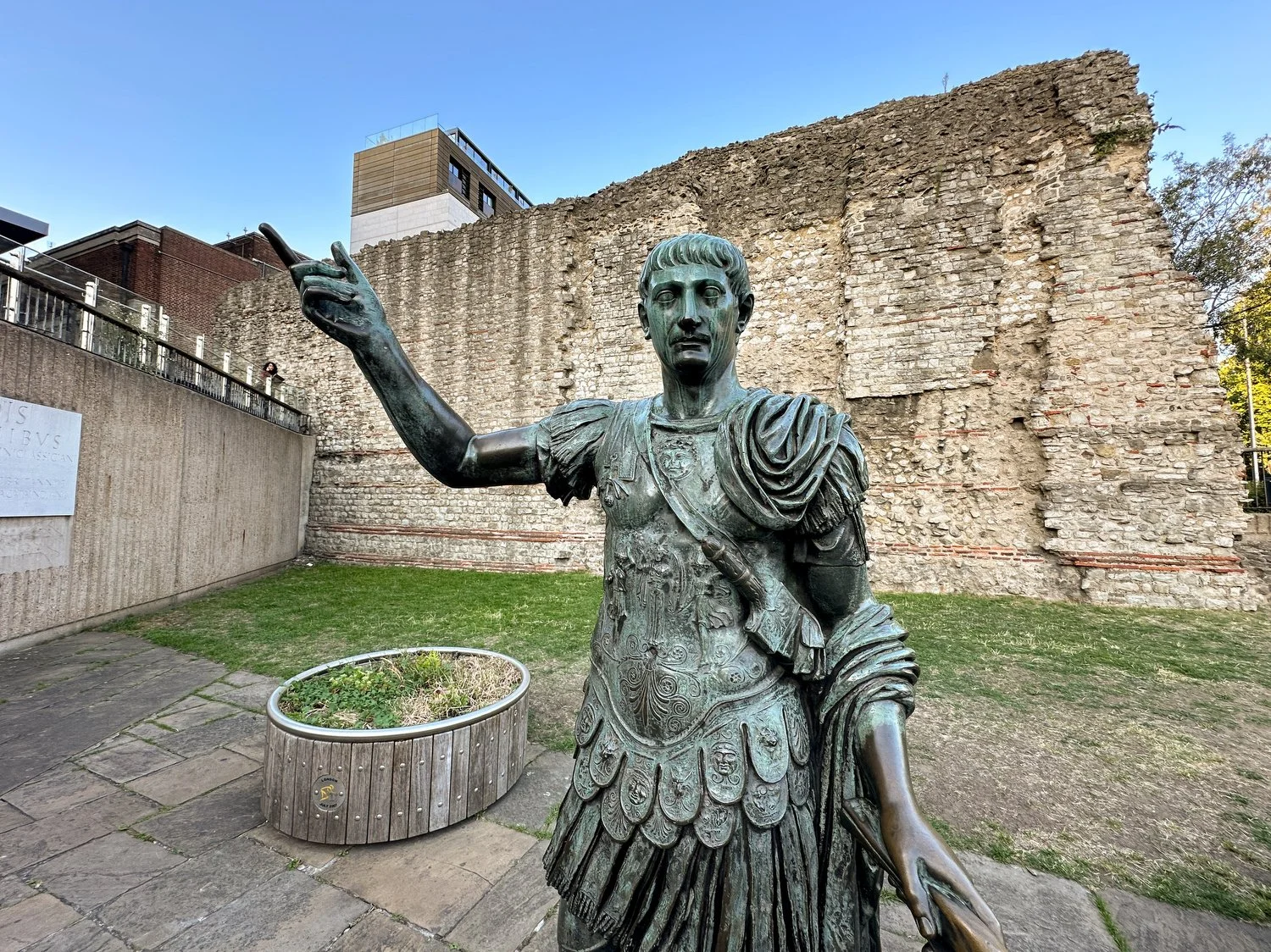


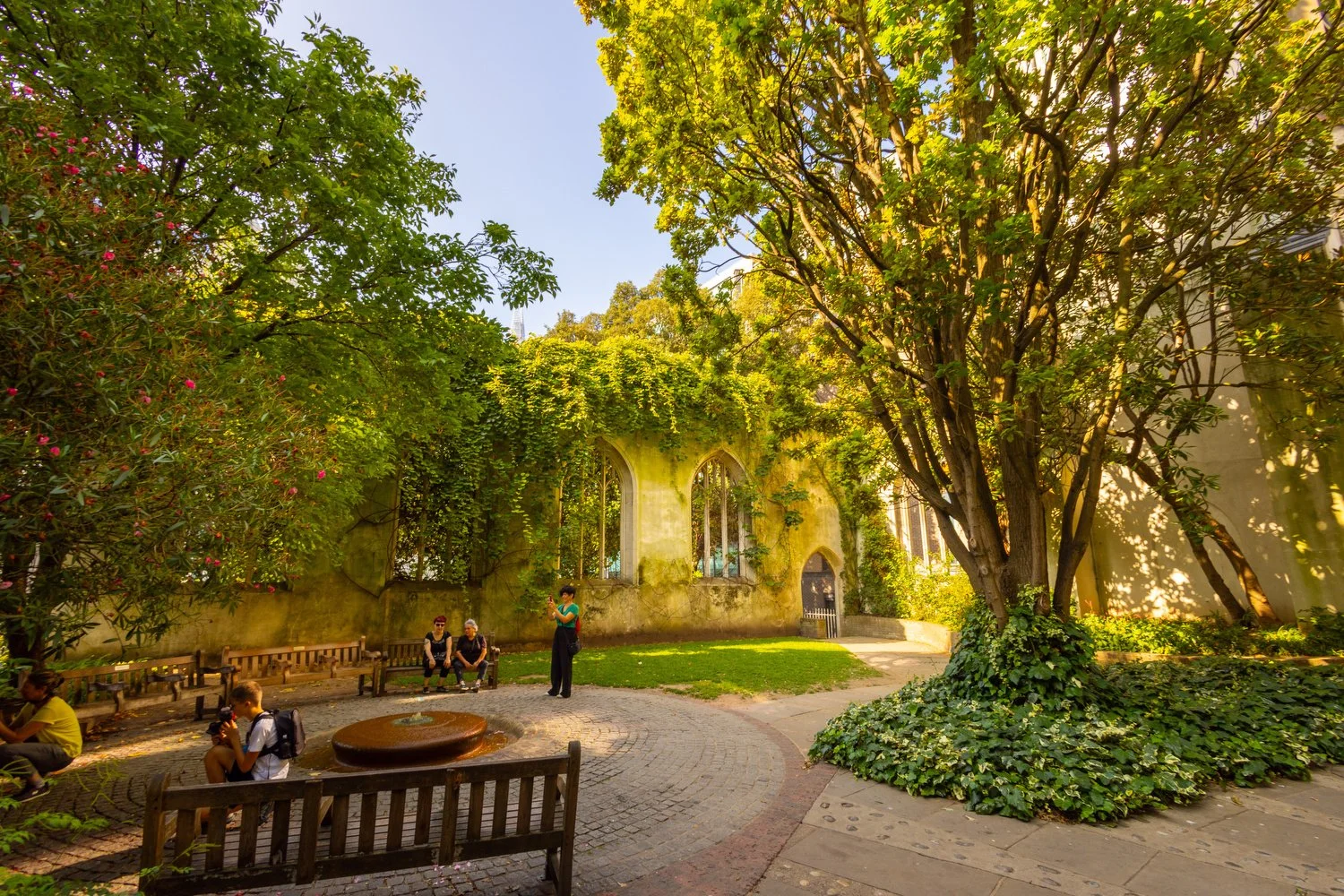


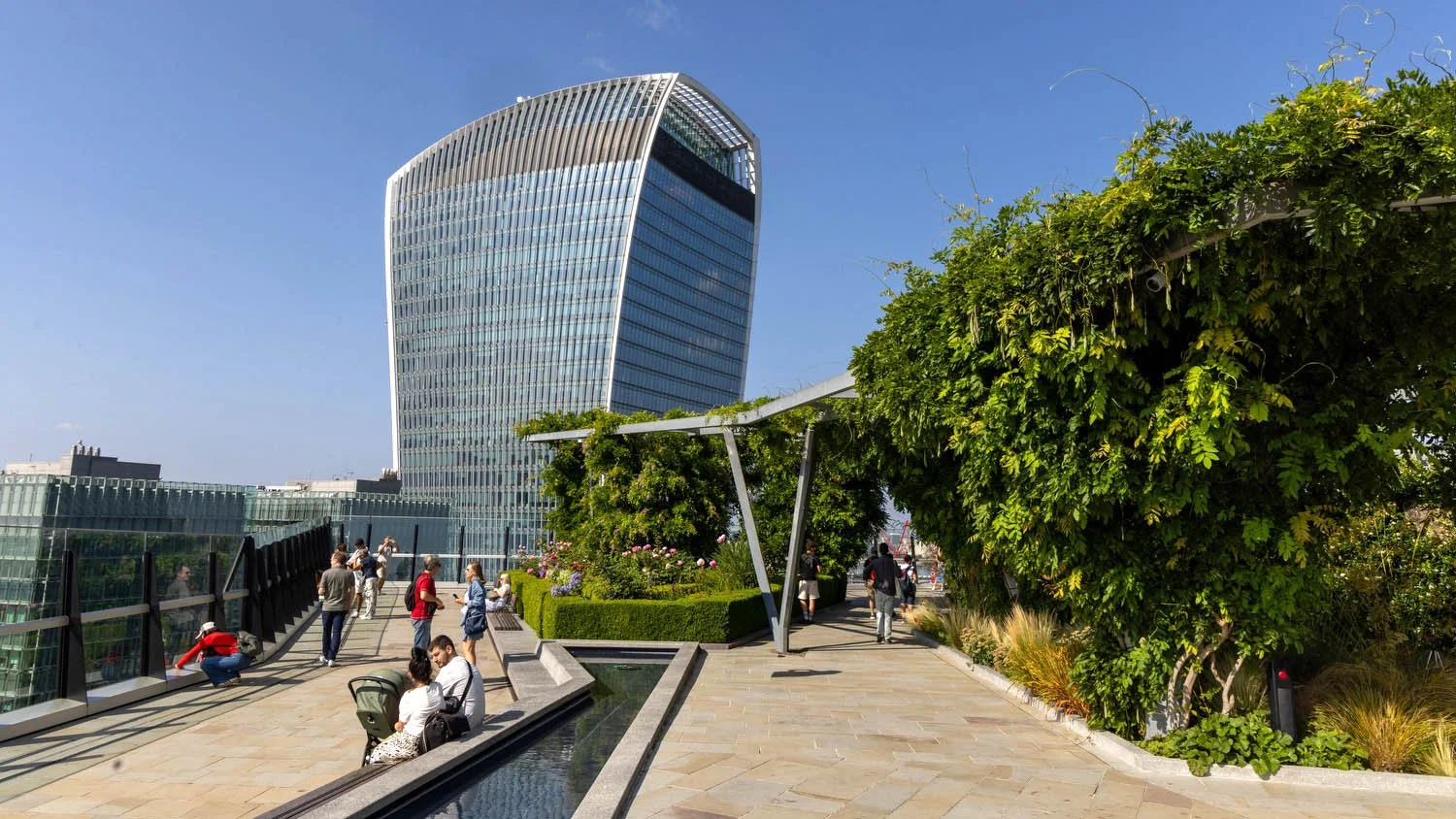
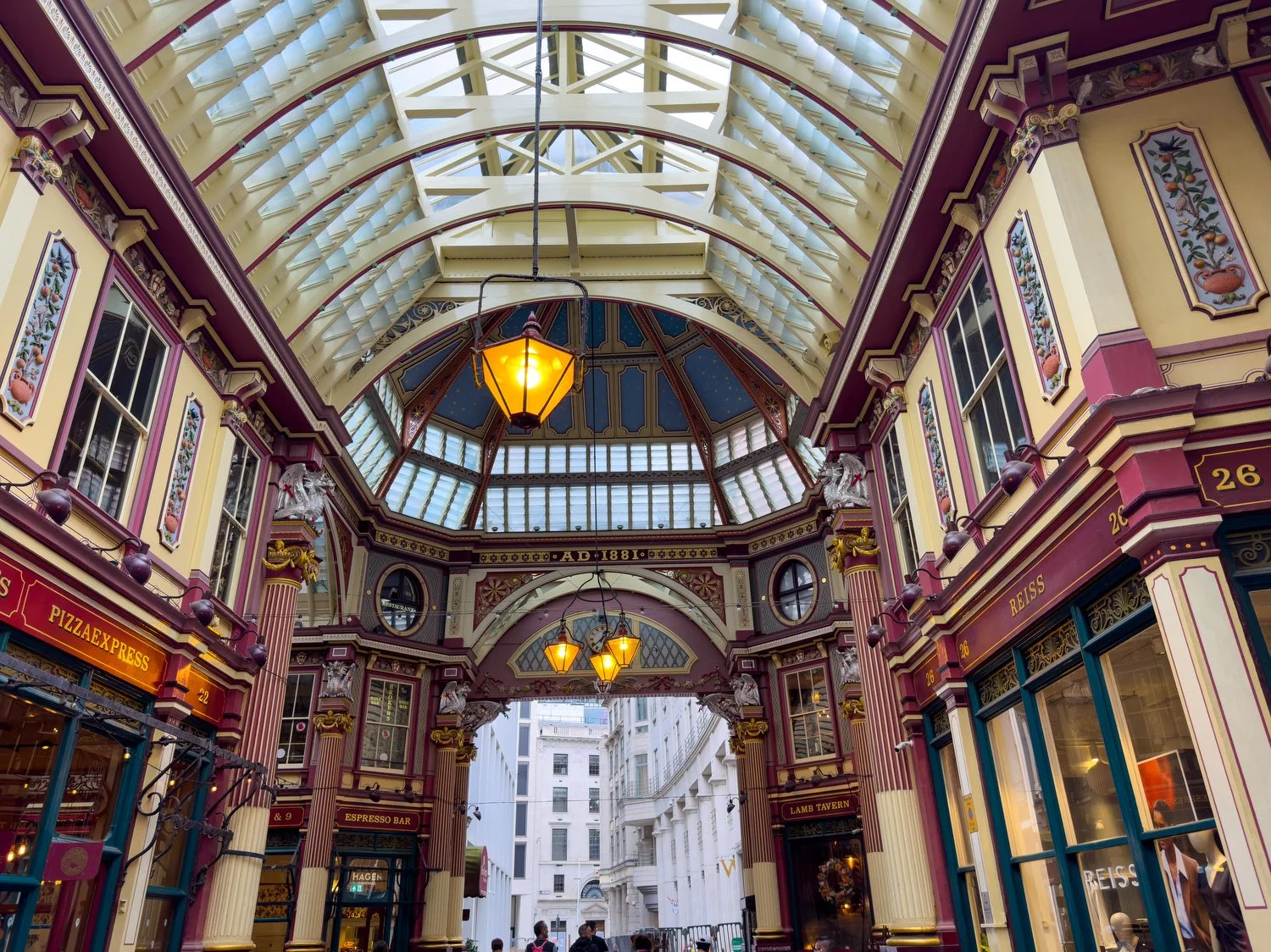


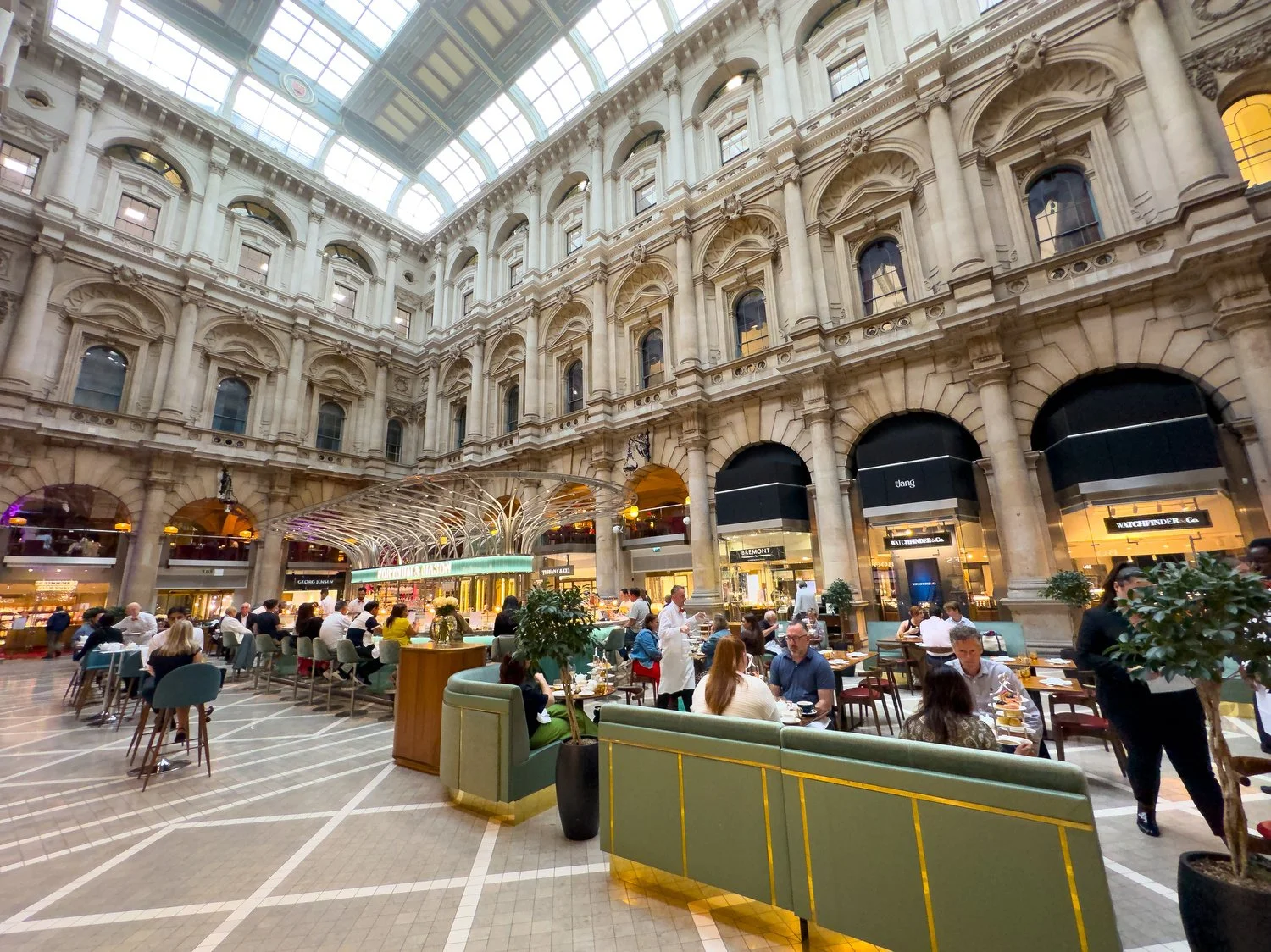


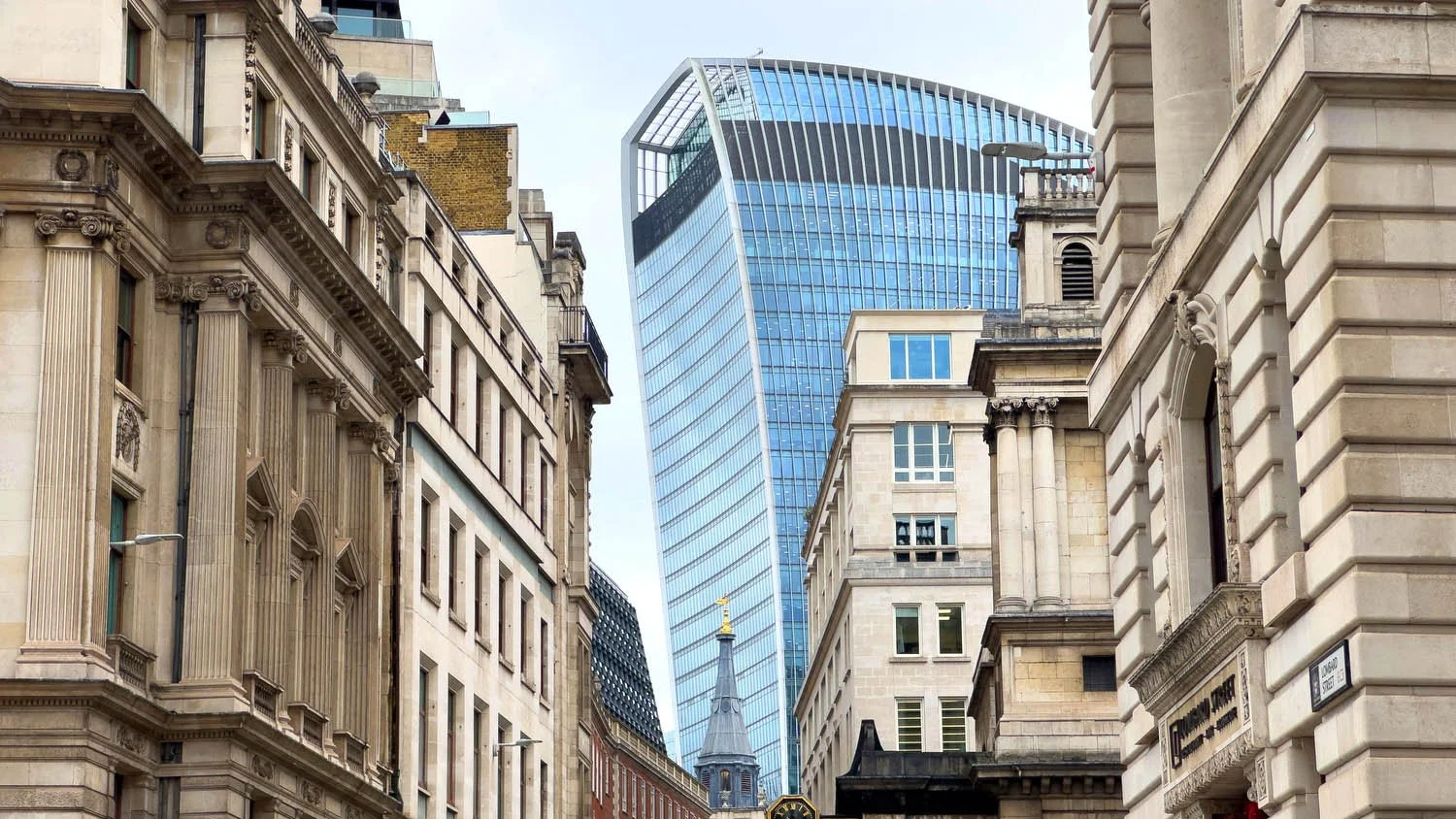
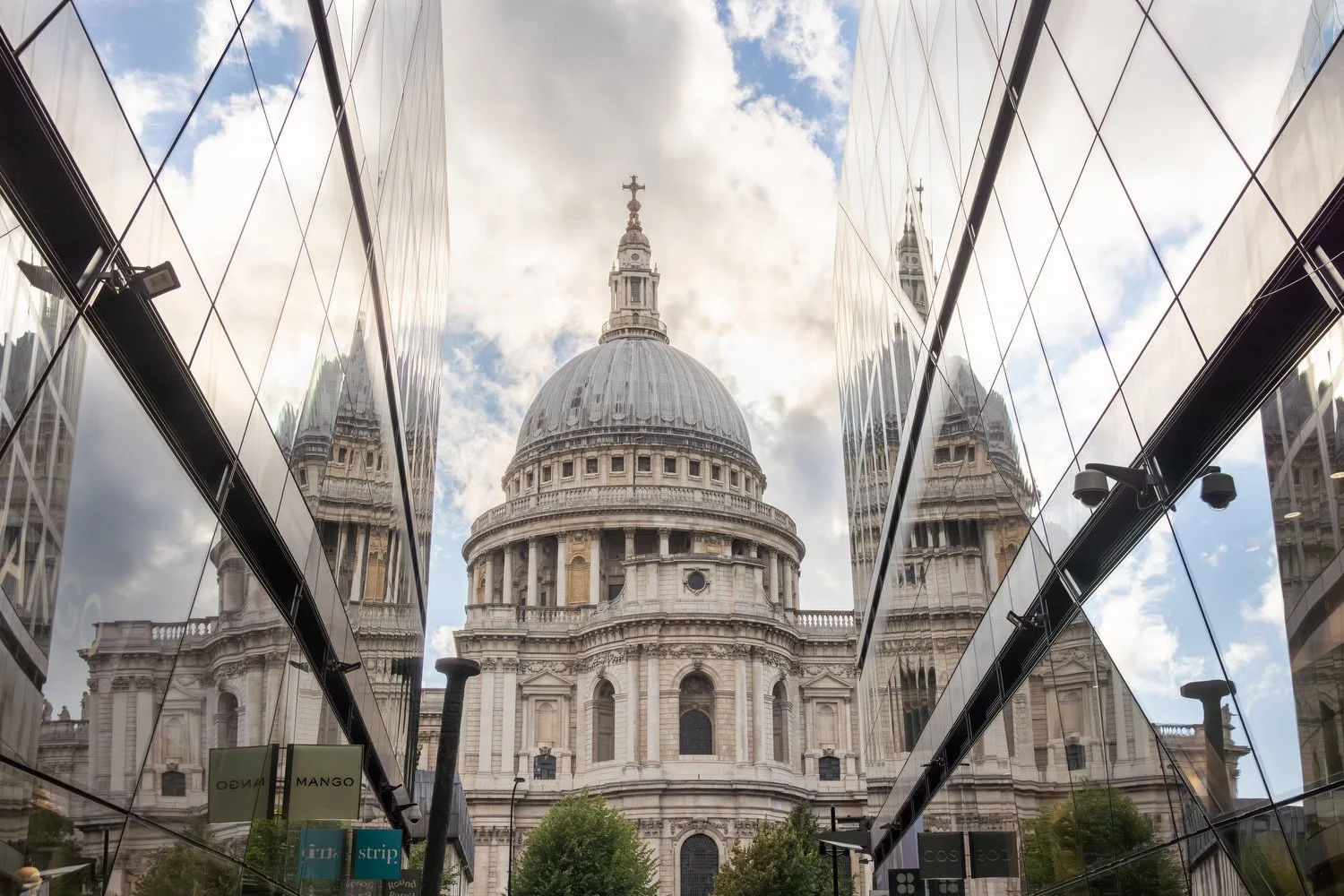
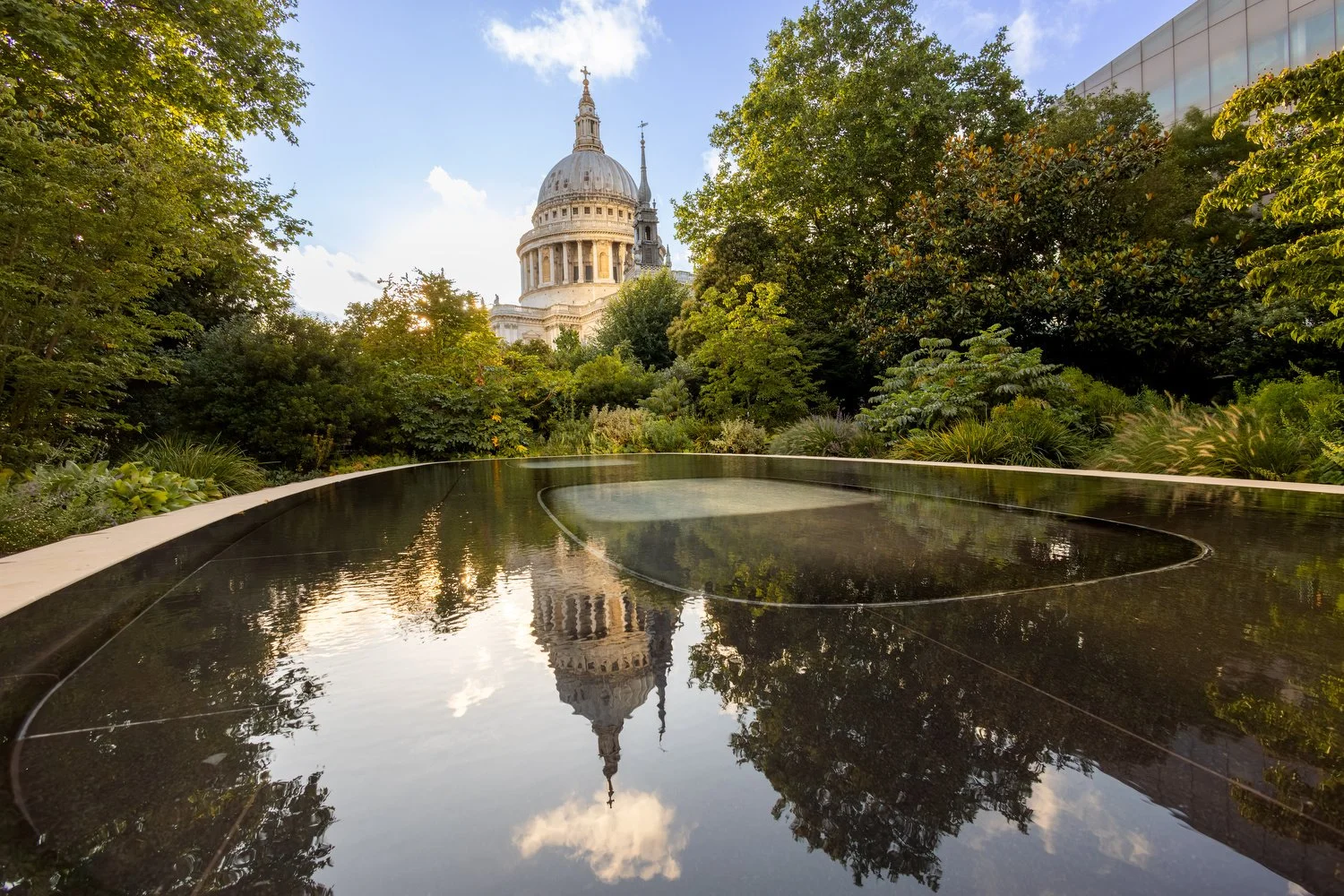
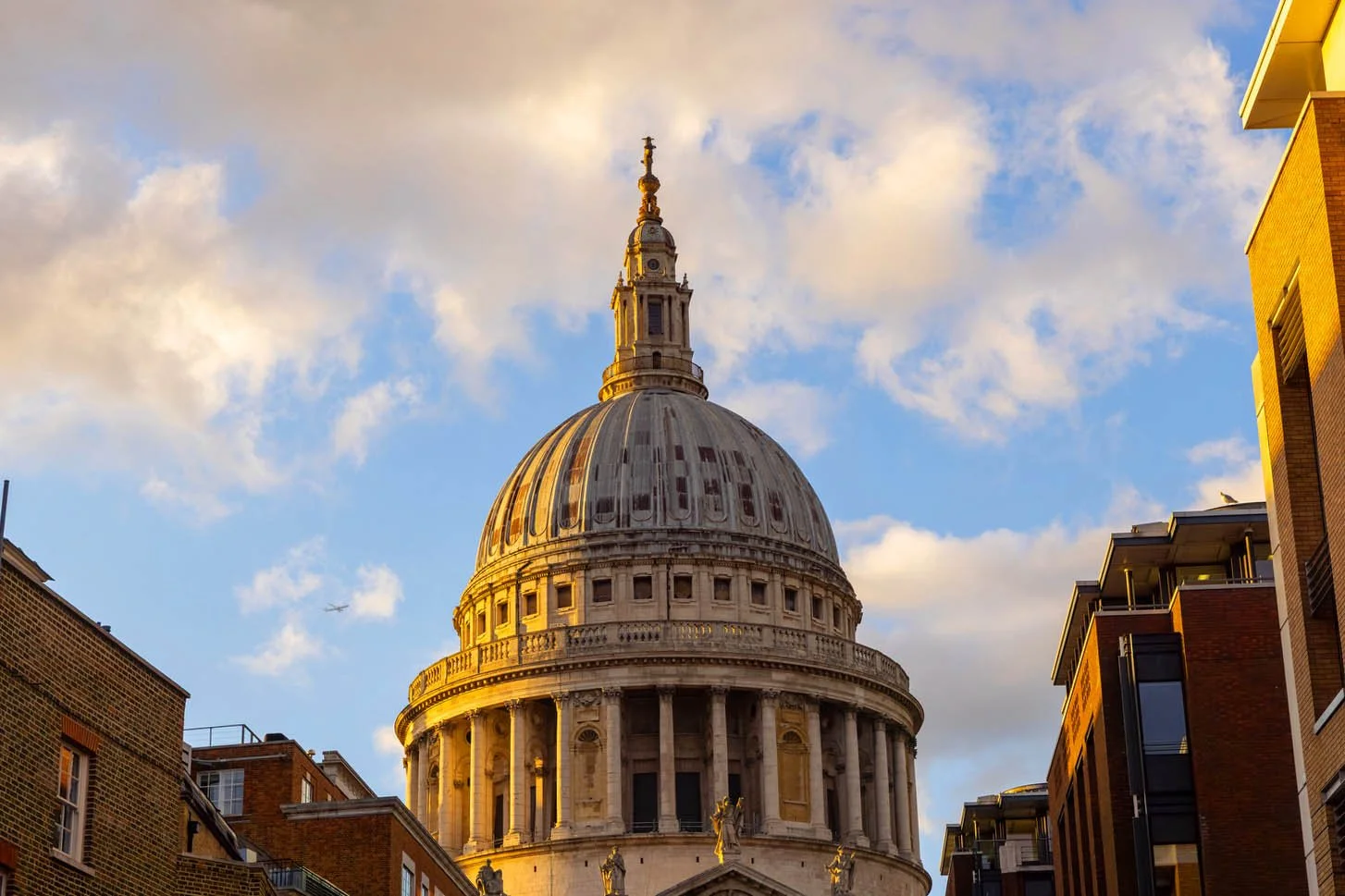
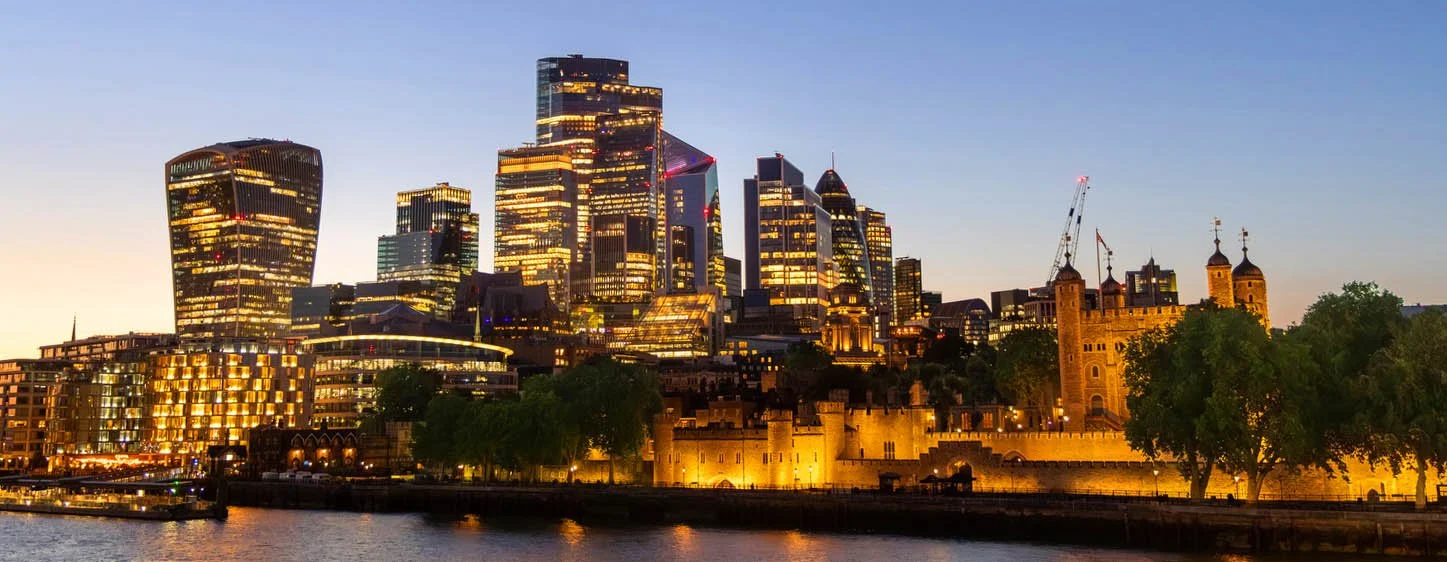









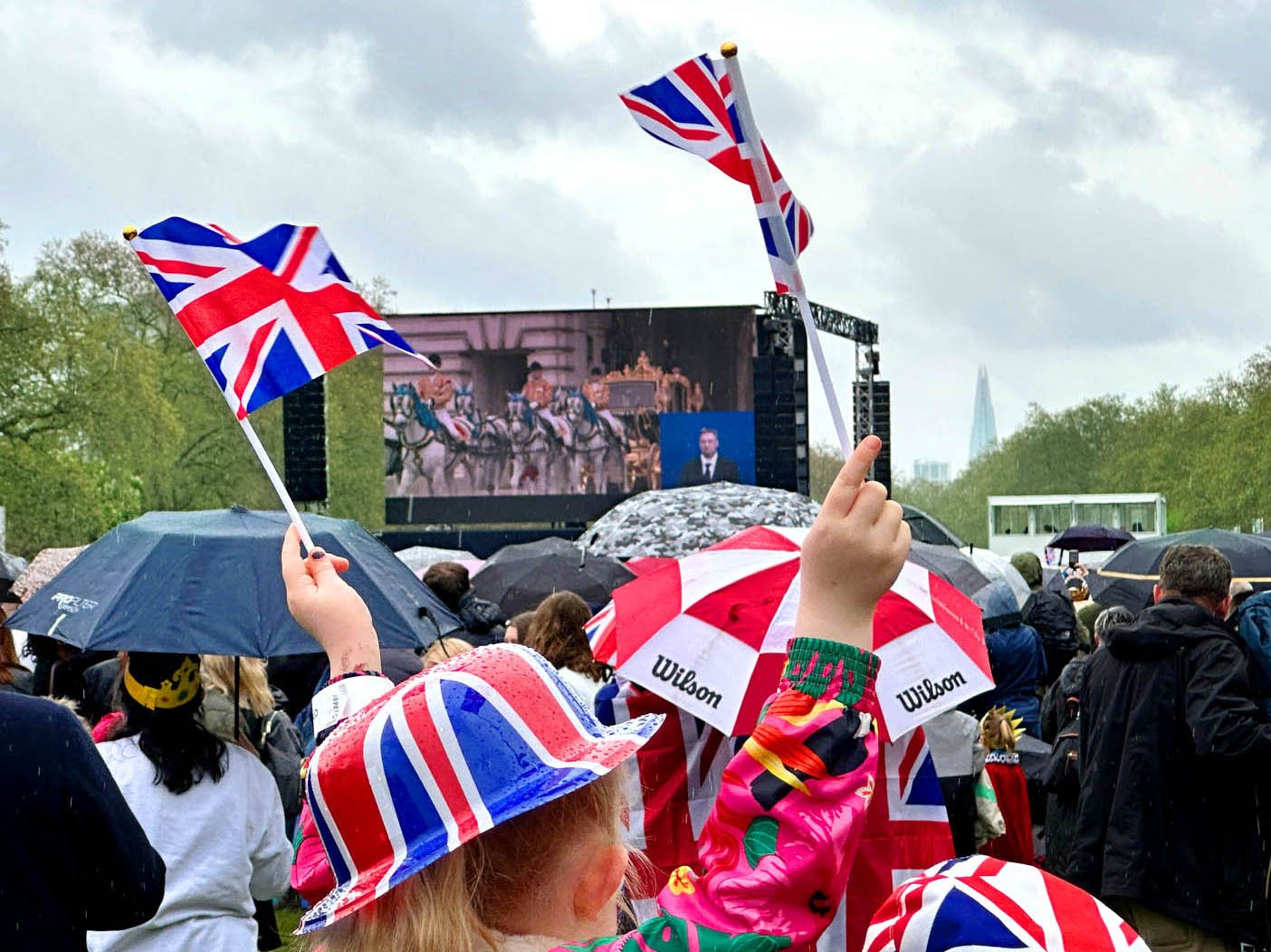






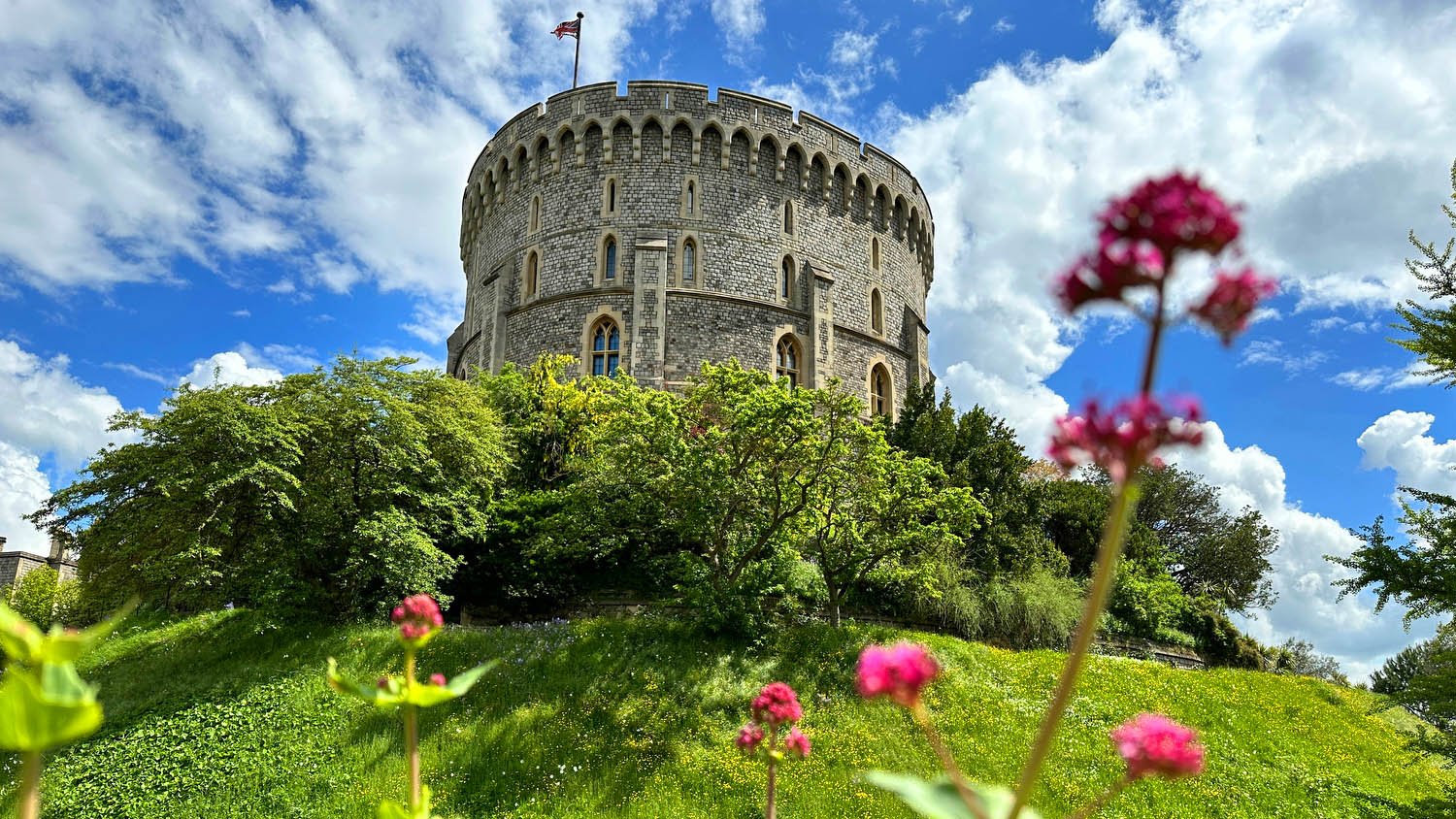
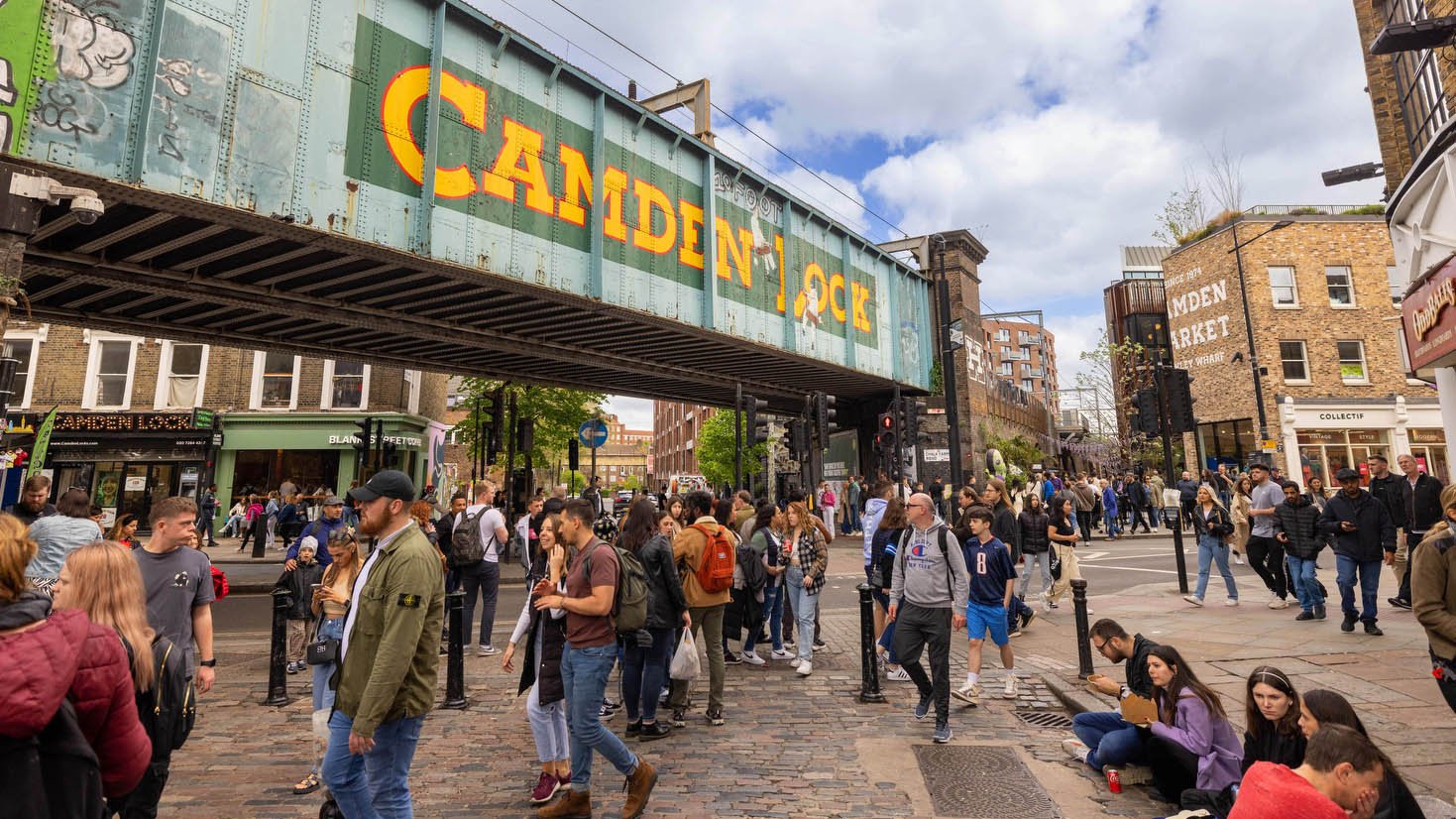
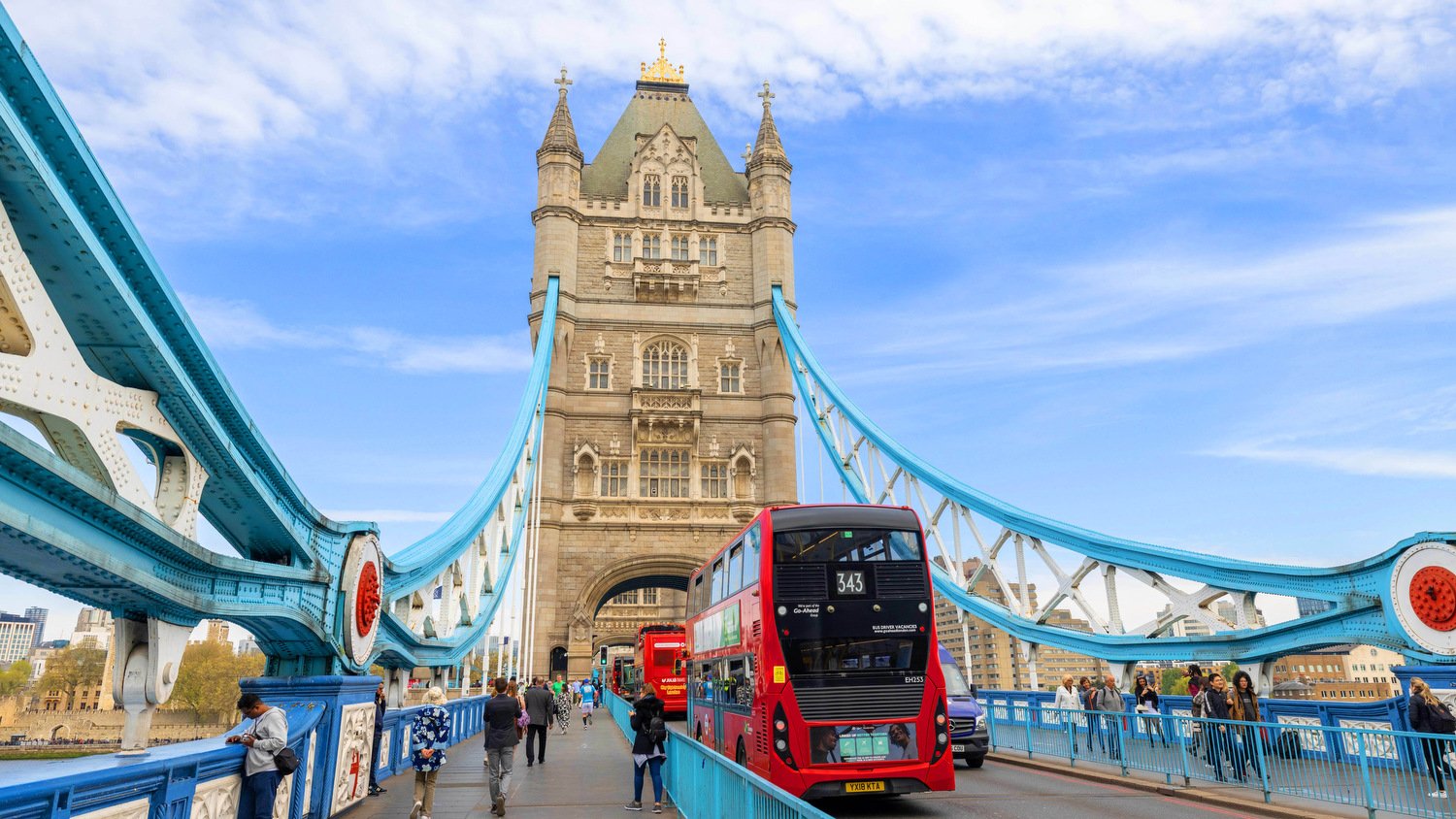
Westminster Abbey is a uniquely historic site in London and a fascinating place to visit.
A royal church with over a thousand years of history, the Abbey is probably the most famous place of worship in the world, and the center of many national events and celebrations.